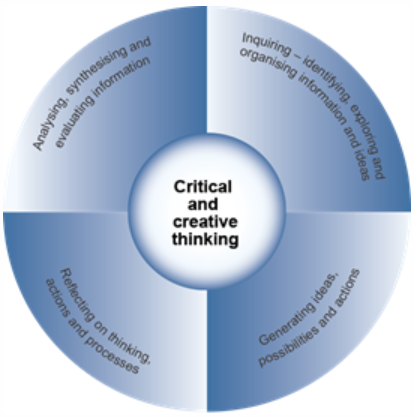Organising elements
The Critical and creative thinking learning continuum is organised into four interrelated elements, each detailing differing aspects of thinking. The elements are not a taxonomy of thinking. Rather, each makes its own contribution to learning and needs to be explicitly and simultaneously developed.
- Inquiring – identifying, exploring and organising information and ideas
- Generating ideas, possibilities and actions
- Reflecting on thinking and processes
- Analysing, synthesising and evaluating reasoning and procedures
The diagram below sets out these elements.
Organising elements for Critical and creative thinking
View AllInquiring – identifying, exploring and organising information and ideas
This element involves students in posing questions and identifying and clarifying information and ideas, followed by organising and processing information. When inquiring – identifying, exploring and clarifying information and ideas, students use questioning to investigate and analyse ideas and issues, make sense of and assess information and ideas, and collect, compare and evaluate information from a range of sources. In summary, in the process of inquiring students primarily:
- pose questions
- identify and clarify information and ideas
- organise and process information.
Generating ideas, possibilities and actions
This element involves students in imagining possibilities and connecting ideas through considering alternatives and seeking solutions and putting ideas into action. Students create new, and expand on known, ideas. They explore situations and generate alternatives to guide actions and experiment with and assess options and actions when seeking solutions. In summary, generating primarily consists of:
- imagine possibilities and connect ideas
- consider alternatives
- seek solutions and put ideas into action.
Reflecting on thinking and processes
This element involves students thinking about thinking (metacognition), reflecting on actions and processes, and transferring knowledge into new contexts to create alternatives or open up possibilities. Students reflect on, adjust and explain their thinking and identify the thinking behind choices, strategies and actions taken. They apply knowledge gained in one context to clarify another. In summary, reflecting primarily consists of:
- think about thinking (metacognition)
- reflect on processes
- transfer knowledge into new contexts.
Analysing, synthesising and evaluating reasoning and procedures
This element involves students in applying logic and reasoning, drawing conclusions and designing a course of action and evaluating procedures and outcomes. Students consider and assess the logic and reasoning behind choices, they differentiate components of decisions made and actions taken and assess ideas, methods and outcomes against criteria. In summary, analysing primarily consists of:
- apply logic and reasoning
- evaluate procedures and outcomes.
- draw conclusions and design a course of action.

